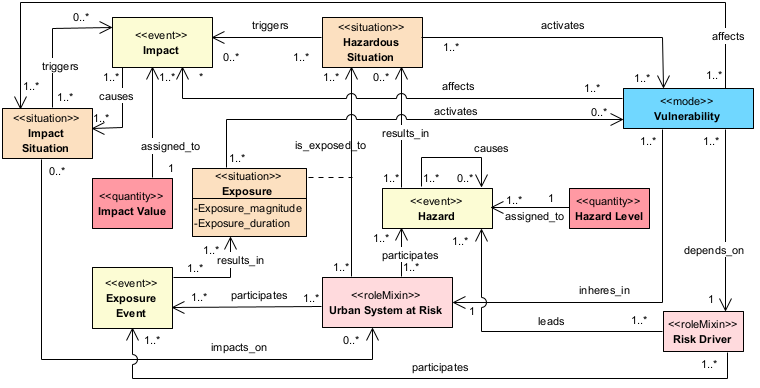|
|
|
Risk-driven Ontology of Urban Systems - complemento : Package
Class Diagram - Risk-driven Ontology of Urban Systems - complemento
![]() link
link
| Jump to: |

|
| Model Elements |
| Name | Description | ||
|
|
[IPCC] "Exposure is the presence of people, livelihoods, species or ecosystems, environmental functions, services, and resources, infrastructure, or economic, social, or cultural assets in places and settings that could be adversely affected." |
||
|
|
Exposure event is the action of dispose people; livelihoods; species or ecosystems; environmental functions, services and resources; infrastructure; or economic, social or cultural assets in places and settings that could be adversely affected by hazards. |
||
|
|
[IPCC] Hazard is the possibility of a physical event or event pattern, which could be either natural or human-caused, that has the capacity to result in loss of life, injury, or other detrimental health effects, as well as property, infrastructure, livelihoods, service provision, ecosystems, and environmental resource damage and loss.
Hazard is any kind of action/event that has a potential danger in itself. Some actions, such as driving a car and traveling by plane, have the potential to cause an adverse event, i.e. a negative impact that can be damage or loss. These activities can trigger a sequence of dangerous events that can result in a hazardous situation (e.g. driving a car on poorly maintained roads). This hazardous situation can activate existing vulnerabilities in the car/driver, e.g. worn tires, the driver's lack of driving experience, leading to an exposure to danger and therefore potentially resulting in an adverse event (e.g. a collision, a rollover, etc.).
A hazard event grounds urban risks. An urban risk is a relation between a risk driver and a urban system at risk that indicates any occurrence of potential damage or loss to the urban system. The impact of the risk can be measured according to the value attributed to the elements (potentially) affected by the risk and by the hazard.
In turn, hazard situations trigger hazard events. This means that the existence of a set of Hazardous Situations can result in a set of (contingent) Risks. The relation between the risk driver and the urban system at risk is based on these events. In turn, a hazard events can lead to a chain of hazard events. |
||
|
|
|||
|
|
|||
|
|
Impacts are events that result in situations of impacts on urban systems. It is a type of one or more resulting events from realized risks. In the context of climate change, the consequences of realized risks on natural and human systems, where risks result from the interactions of climate-related hazards (including extreme weather/climate events), exposure, and vulnerability. |
||
|
|
Impacts generally refer to effects on lives, livelihoods, health and well-being, ecosystems and species, economic, social, and cultural assets, services (including ecosystem services), and infrastructure. Impacts may be referred to as consequences or outcomes and can be adverse or beneficial. In the model, only the type of adverse impact.
Impacts are also defined as the quantification of the overall potential damage and losses that a reference event may generate in the same area and in a set timeframe.
Effects on natural and human systems. In this report, the term ‘impacts’ is used to refer to the effects on natural and human systems of physical events, of disasters, and of climate change.
Source: https://archive.ipcc.ch/pdf/special-reports/srex/SREX-Annex_Glossary.pdf |
||
|
|
|||
|
|
1. [IPCC] Any natural or human-induced factor that directly or indirectly causes a change in a system (adapted from MA, 2005).
2. It encompasses both natural and human-induced factors, processes, or conditions that result in a direct or indirect alteration of a system.
Available at: https://civil-protection-knowledge-network.europa.eu/eu-overview-risks |
||
|
|
An urban system is a set of interconnected parts (population, urban space, and infrastructure). An urban system at risk has one or more parts vulnerable or exposed to certain risk drivers in certain situations. |
||
|
|
The propensity or predisposition to be adversely affected. Vulnerability encompasses a variety of concepts and elements, including sensitivity or susceptibility to harm and lack of capacity to cope and adapt.
Vulnerability expresses the relationship between the intensity of an adverse event, the features of the elements at risk (assets, community, system, environment) that affect their behavior, and the measure of the damage resulting from the event (response). Uncertainty in assessing vulnerability is due to insufficient knowledge of the features affecting the response and the possible effects on the elements exposed to an event.
Vulnerability is defined in different ways depending on the types of risk being assessed. In seismic risks, vulnerability is the probability that an element at risk, belonging to a specific behavioral class (vulnerability class), experiences or exceeds a damage threshold (according to a predetermined scale of damage) upon the occurrence of an event of an assigned intensity. In flood risks, vulnerability expresses the expected damage to the elements at risk, the extent of damage ranging from 0 (no damage) to 1 (total destruction). |
||